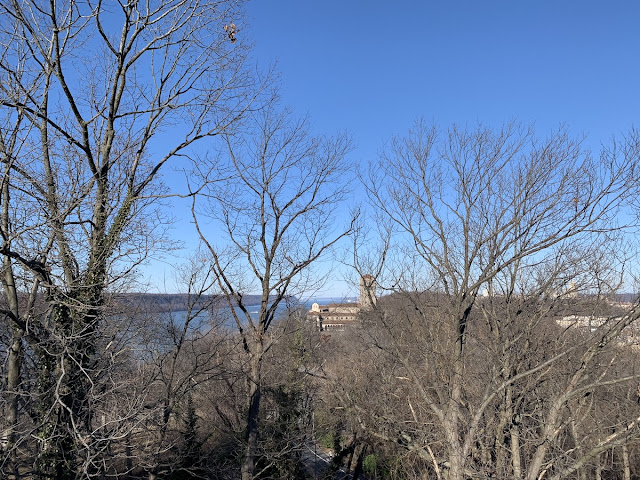Those who long to get outside, view inspiring landscapes, and also catch up on New Year’s exercise resolutions should make their way to Upper Manhattan. Up here, the island has not been entirely flattened like the southern parts. A walk uptown, generally north of 175th Street, often incorporates a challenging climb.
 |
| View of The Met Cloisters from the second highest territorial point (260 ft) in Manhattan |
This walk, beginning with the two highest points in Manhattan and then leading down to the eastern shore of the Hudson River, offers not only great scenery but also serves as an overview of the apartment life and streetscapes of this largely residential area west of Broadway.
 |
| Linden Terrace in Fort Tryon Park |
Walking uptown near the Hudson River can easily invite comparisons to walks in the European countryside, even if those visions mainly come from fairytales. Beginning with a view of the Cloisters, the Metropolitan Museum of Art’s branch that houses its medieval art collection, the local built environment takes in a considerable amount of medieval-inspired architecture. Medieval castle fortresses inspired Castle Village on Cabrini Boulevard, and Hudson View Gardens on Cabrini and Pinehurst Avenue includes Tudor-style architectural elements. So be on the lookout for turrets.
 |
| Fort Tryon Cottage |
Begin the walk in Fort Tryon Park at Linden Terrace, a raised area just north of the park’s entrance at the end of the promenade. Many locals frequent this peaceful space. Lined with tall trees, the perch offers great views of the Hudson River and the Palisades beyond. To get to the second highest point in Manhattan, just take a few more steps to the area with the flagpole. Here, the surrounding neighborhood landscape unfolds to the east.
 |
| Cabrini Woods, a nature sanctuary overlooking the Hudson River |
Return back to the park entrance and turn right toward the river. Before continuing on Cabrini Boulevard, stop to look at the Fort Tryon Cottage, just northwest of Corbin Circle. The cottage was originally a gatehouse for the C. K. G. Billings estate, a place that once housed a Gilded Age mansion that was subsequently destroyed by fire. A spectacular arcade that functioned as the driveway still remains. The picturesque cottage is now used as a northern Manhattan base for NYC Parks.
 |
| Bennett Park |
Continue down Cabrini Boulevard and stop at Cabrini Woods to look for soaring birds. This small nature sanctuary overlooking the Hudson River is filled with a diversity of trees and is a favorite stopping place for migratory birds along the Atlantic Flyway. In winter, look for bald eagles, as one has been spotted here recently.
 |
| Pinehurst Steps lead down to W. 181st St. |
Walk south to W. 187th Street, a small retail corridor with several shops, bodegas, and restaurants, and look for Pinehurst Avenue at the small triangle. Down Pinehurst you go until you get to Bennett Park, a small neighborhood park frequented by families from the surrounding apartment complexes, the aforementioned medieval and Tudor-inspired dwellings that characterize this section of upper Manhattan. The park boasts the highest territorial point of Manhattan, and if you’ve been playing along, you’ve already stopped at the second highest point at Linden Terrace. (Obviously, we're talking terrain here and not the views from the Empire State Building.)
 |
| W. 181st Street |
Close by to the south is one of the favorite step streets of the neighborhood, spilling down to W. 181st. The streetscape here is lined with some excellent restaurants (Saggio’s, The Uptown Garrison, for example) and pubs (like Le Chéile), situated on a slope dominated by the George Washington Bridge above. Walk west to Riverside Drive for an overview of the river and the bridge.
 |
| The path under the George Washington Bridge |
Please stop. At this point, it must be told, the path ahead can get strenuous. The grade is steep, cyclists whiz past, and the path ends up feeling longer than it looks. Don’t try to walk here in icy weather either.
 |
| The Little Red Lighthouse |
That said, the walk continues over a pedestrian bridge and then winds down to Fort Washington Park. Once here, all is splendid. The Little Red Lighthouse is here, the bridge overhead looks fabulous and large, and most of all, the views from the water are exceptional.
 |
| View of Lower Manhattan from Upper Manhattan |
One of the loveliest sights of all is the view of Manhattan from the water’s edge. On a clear day, with the sun out, the proximity to the sky and river makes this a fitting and almost mystical end to a walk than began on much higher terrain.
Having arrived at this bit of heaven, I would recommend walking back the way you came, back up the path to 181st Street. Take it slow. Try one of the local eateries before heading home. Nearby subways - the A train at Fort Washington Avenue and the 1 train at St. Nicholas Avenue. Don’t try walking further south in the park to W. 158th Street, because that’s much too far and doesn't come with a proper fairytale ending.
Images by Walking Off the Big Apple from February 3, 2020.














